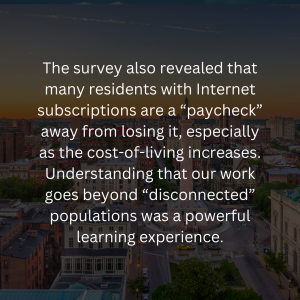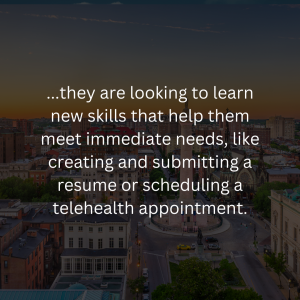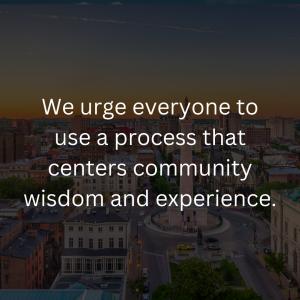
With East Baltimore Development Inc.’s CEO Cheryl Washington
The East Baltimore Development, Inc. (EBDI), a 501(c)(3) organization, was established to revitalize, re-energize, and rebuild an 88-acre area adjacent to the Johns Hopkins medical campus in East Baltimore. It partnered with Microsoft Airband to explore the digital equity needs of residents in and around EBDI’s footprint, which includes five zip codes. The partnership supported the development of a blueprint for achieving digital equity in an urban revitalization project area as it relates to affordable housing, local retail and small business capacity building, workforce development, education, and healthcare. 
The first phase of this project included an analysis of U.S. Census Bureau data, which contrasted home broadband subscription and device ownership in the service area with wealthier parts of Baltimore City. The results underscored the racialized impact of the digital divide. Additionally, EBDI facilitated a community-led survey of East Baltimore residents to document their views on the internet, their access needs, and their priorities for government spending on solutions to close the digital divide. Cheryl Washington, President and CEO of EBDI, shared highlights from the project and its preliminary findings, which will be followed by a more detailed report.
NCC: Why was it important to conduct research on digital equity gaps within the Eager Park area?
CW: A one-size fits all approach would not be as impactful for addressing the unique needs of our community. We understand that the Zip Codes in our service area may have different challenges, barriers, and needs than other neighborhoods in Baltimore so it was important for us to connect directly with those living and working in Eager Park. To attract and retain residents and businesses – to create a thriving community – we must ensure everyone has the information and resources they need to access and utilize technology.
Also, EBDI prides itself on engaging the community on every level of the planning and execution of our human capital initiatives like digital equity. We need our initiatives to be informed by the community so we can best address their needs.
NCC: Your team surveyed residents about their lived experiences. What did the qualitative information reveal that may not have been captured with traditional quantitative data collections?
CW: Qualitative information gleaned from the surveys revealed perceptions of technology which are themselves barriers to use and access. We discovered a desire to have public Wi-Fi, specifically in our public park. Additionally, digital training requests vary from how to access telehealth to accessing reliable news. Data security – trust in what they are accessing and who is providing them with the devices or could be selling their personal data– was another key area of concern revealed. 
The survey also revealed that many residents with Internet subscriptions are a “paycheck” away from losing it, especially as the cost-of-living increases. Understanding that our work goes beyond “disconnected” populations was a powerful learning experience.
NCC: How did you arrive at the conclusion that there is no one size fits all solution to closing digital divides? What were some of the highlights of the analysis?
CW: Traditional, one-size fits all approaches to narrowing the digital divide at the local level usually include ensuring households have devices and Wi-Fi. We understand that, in many cases, households need faster, more reliable Wi-Fi along with multiple devices to meet the demand of multiple students or people working from home.
Additionally, our surveys show that it is most important to our community that the [digital skills] training and curriculum are designed and delivered with an understanding of the community’s unique needs and concerns. We heard from many respondents that training sessions—which can take up a significant amount of time—are not conducive to their lives. Instead, they are looking to learn new skills that help them meet immediate needs, like creating and submitting a resume or scheduling a telehealth appointment. 
NCC: What does this report mean for the future of digital equity work in Baltimore as a whole? How could it inform research in other digitally disadvantaged communities?
CW: It is important for those seeking digital equity solutions to understand how communities across Baltimore might be impacted differently and may have varying needs. Baltimore and other cities across the country have a multitude of organizations addressing the digital divide. We hope that our report helps them to consider more customized solutions. It reiterates the importance of listening to a community to gain buy-in and trust to implement programs and initiatives. Community development organizations have an important role to play and have been underutilized as digital equity champions.
NCC: What advice would you give to other communities seeking to pursue digital equity work?
CW: Even today, there is a common perception that technology is too difficult to understand and should be left to business and technology experts. Our survey, like work across the country, proves that wrong. Residents are quite clear about what they need and what needs to be done to improve their broadband access and experiences online. We urge everyone to use a process that centers community wisdom and experience.
A collaborative, inclusive approach will be more successful because you will gain trust and buy-in from the community. If the scope of your digital equity work is appropriately informed by the community you serve, you will achieve a greater impact.

